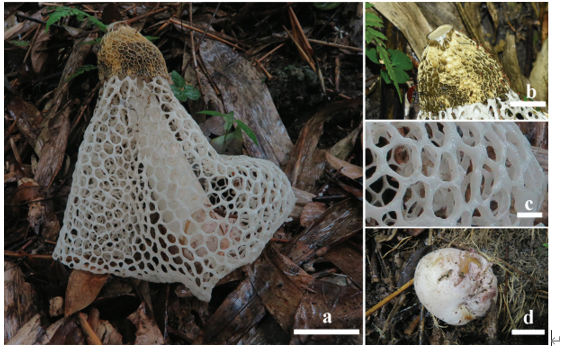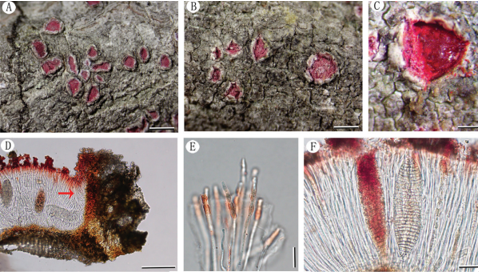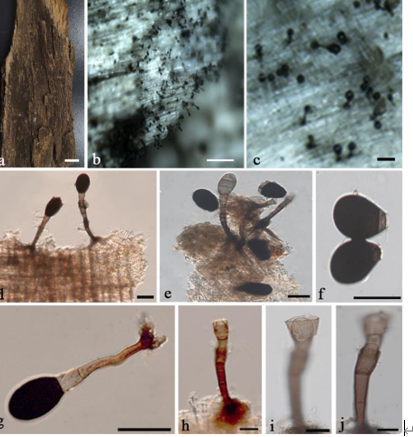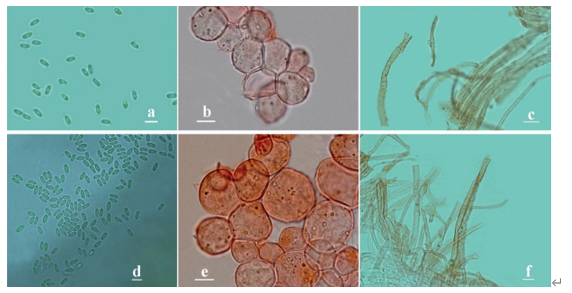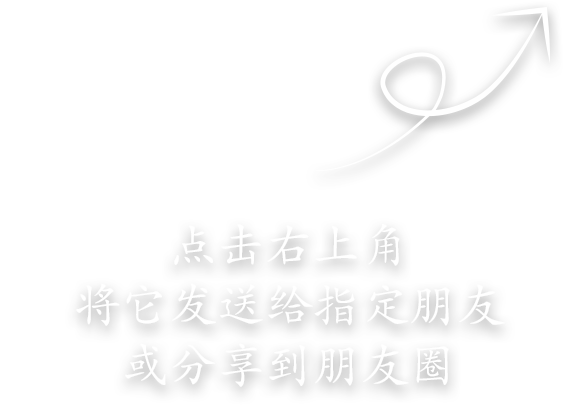Cortinarius neotorvus Y. Li, M.L. Xie & T.Z. Wei, sp. nov. 2020
MycoBank No: 835346
Holotype: China. Jilin Province: Antu County, Liangjiang Town, Dongfanghong Village, broadleaf forest (Quercus mongolica dominated forest with some Juglans and Acer), 42°42'51"N, 128°01'10"E, alt. 640 m, 5 August 2017, M.L. Xie, HMJAU44441, GenBank No. (ITS) MK552384.
Morphological description
Pileus 2–4.4 cm in diam., hemispherical when young, then convex to almost plane with a low, broad umbo, weakly hygrophanous, orange grey (5B2), paler at the margin, surface with greyish-white fibrillose. Lamellae emarginate, mediumspaced, yellowish-grey (4B2), greyish-red (9B4–6) when young, sometimes with violet tinge when young, margin paler, slightly serrate. Stipe 4.1–10.5 cm long, 0.5–0.7 cm thick at apex, 0.3–0.5 cm thick at base, cylindrical to somewhat tapering towards base, orange grey (5B2) when moist, sometimes with violet tinge at the apex when young, surface with richly whitish fibrillose. Universal veil greyish-yellow (4B3), copious, usually forming a girdle on the upper stipe, cortina white. Context white (A1), marbled watery when moist, sometimes with violet tinge at the apex of the stipe. Odour indistinct. Exsiccata brown (6E5) to dark brown (6F6).
Basidiospores 8.5–10.2 × 5.8–6.9 μm, Q = 1.31–1.67, `X = 9.0–9.9 × 6.1–6.5 μm,
`Q = 1.45–1.61 (130 spores, 6 collections), ellipsoid, moderately verrucose, moderate- ly dextrinoid. Basidia 4-spored, cylindrical to clavate, 27–53 × 7–12 μm, thin-walled, hyaline to olivaceous brown in 5% KOH. Lamellar edge sterile, sterile cells cylindricalclavate, 11–26 × 3–9 μm, thin-walled, hyaline in 5% KOH. Lamellar trama hyphae regular, pale olivaceous in 5% KOH, smooth. Universal veil hyphae thin-walled, hyaline to pale olivaceous yellow in 5% KOH. Pileipellis: epicutis hyphae cylindrical, 2–6 μm wide, olivaceous brown in 5% KOH, smooth; hypocutis well developed, hyphae 15–38 μm wide, sub-cellular, thin-walled, hyaline in 5% KOH, smooth. Pileus trama hyphae thin-walled, hyaline to slightly olivaceous in 5% KOH, smooth. Clamp connections present.
Habitat: In broadleaf forest (Quercus mongolica dominated forest).
Distribution: Jilin and Heilongjiang Province, China.
GenBank Accession:NO MK552383, MK552384, MK552385, MK552386, MK552382
Notes: Cortinarius neotorvus is easily confused with C. torvus due to highly similar morphology. Morphologically, the lamellae of C. torvus are adnate to subdecurrent and distant (Bidaud et al. 1999; Breitenbach and Kränzlin 2000; Soop 2014) and the pileus colour of C. torvus is usually darker and with a violet tinge, as well as the stipe usually being bulbous at the base (Consiglio et al. 2003). In mo- lecular data, the ITS sequence of C. neotorvus (MK552384, holotype) differ from the sequences of C. torvus (AY669668, JX407337) by six substitutions and five indels. In the phylogenetic analyses, the five specimens of C. neotorvus were placed in separate monophyletic lineages (BPP = 0.96, MLBS = 90%) and formed a sister relationship with C. torvus.
Reference: Xie M-L, Wei T-Z, Fu Y-P et al. (2020) Three new species of Cortinarius subgenus Telamonia (Cortinariaceae, Agaricales) from China.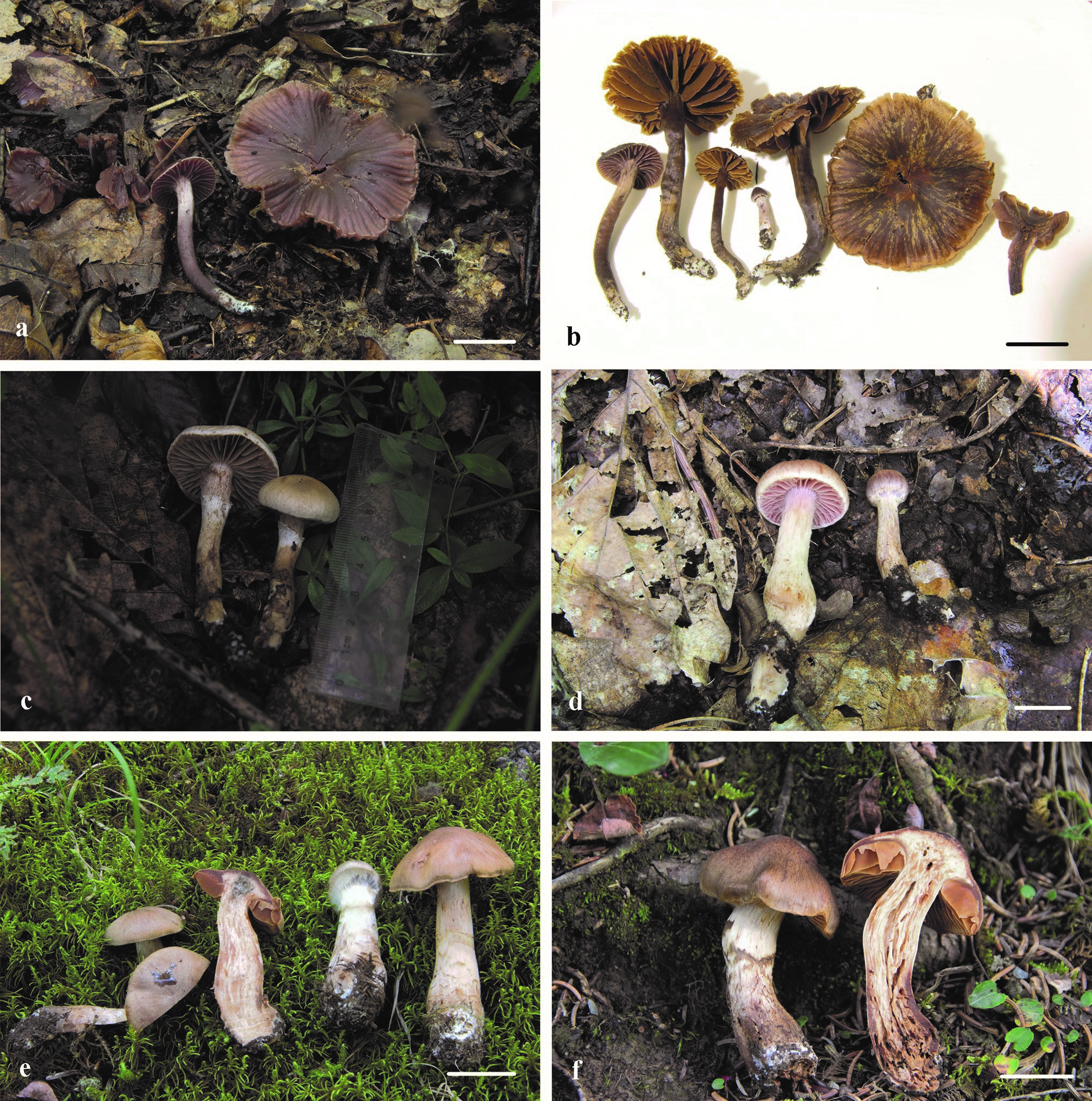
Basidiocarps of three newly-described species. c, d Cortinarius neotorvus (c HMJAU44441, holotype; d HMJAU44439)
Basidiospores of three newly-described species. b Cortinarius neotorvus (HMJAU44441, holotype) 
Margin cells of three newly-described species. b Cortinarius neotorvus (HMJAU44441, holotype)


